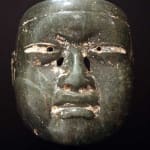Olmec Jade-Greenstone Mask, 900 BCE - 500 CE
Jade/Greenstone
8
PF.4516a
Further images
-
(View a larger image of thumbnail 1
)

-
(View a larger image of thumbnail 2
)

-
(View a larger image of thumbnail 3
)

-
(View a larger image of thumbnail 4
)

-
(View a larger image of thumbnail 5
)

-
(View a larger image of thumbnail 6
)

-
(View a larger image of thumbnail 7
)

-
(View a larger image of thumbnail 8
)

The Olmecs are generally considered to be the ultimate ancestor of all subsequent Mesoamerican civilisations. Thriving between about 1200 and 400 BC, their base was the tropical lowlands of south...
The Olmecs are generally considered to be the ultimate ancestor of all subsequent Mesoamerican civilisations. Thriving between about 1200 and 400 BC, their base was the tropical lowlands of south central Mexico, an area characterized by swamps punctuated by low hill ridges and volcanoes. Here the Olmecs practiced advanced farming techniques and constructed many permanent settlements. Their influence, both cultural and political, extended far beyond their boundaries; the exotic nature of Olmec designs became synonymous with elite status in other (predominantly highland) groups, with evidence for exchange of artefacts in both directions. Other than their art (see below), they are credited with the foundations of writing systems (the loosely defined Epi-Olmec period, c. 500 BC), the first use of the zero – so instrumental in the Maya long count vigesimal calendrical system – and they also appear to have been the originators of the famous Mesoamerican ballgame so prevalent among later cultures in the region. The art form for which the Olmecs are best known, the monumental stone heads weighing up to forty tons, are generally believed to depict kingly leaders or possibly ancestors. Other symbols abound in their stylistic repertoire, including several presumably religious symbols such as the feathered serpent and the rain spirit, which persisted in subsequent and related cultures until the middle ages.
Comparatively little is known of their magico-religious world, although the clues that we have are tantalising. Technically, these include all non- secular items, of which there is a fascinating array. The best- known forms are jade and ceramic figures and celts that depict men, animals and fantastical beasts with both anthropomorphic and zoomorphic characteristics. Their size and general appearance suggests that they were domestically- or institutionally-based totems or divinities. The quality of production is astonishing, particularly if one considers the technology available, the early date of the pieces, and the dearth of earlier works upon which the Olmec sculptors could draw. Some pieces are highly stylised, while others demonstrate striking naturalism with deliberate expressionist interpretation of some facial features (notably up-turned mouths and slit eyes) that can be clearly seen in the current mask.
Olmec masks with human features are among the most beautiful sculptures of jade and serpentine produced by Olmec lapidaries. It is difficult to determine how these works of art functioned in Olmec life, but it is more than likely that this beautiful jade mask was used in funerary rituals, either placed over the face of the deceased lord before burial or interred with his ashes after cremation. In either case, this sculpture portrayed the features of the dead lord in the most precious material known to Olmec artists. Even today, with state of the art equipment, a sculptor would be considered a master to have produced a work of art such as this mask. Through this artist's brilliance the inherent beauty and warmth of the jade has been enriched, refined into something more than material- a palpable, almost flesh like feeling which radiates its own natural light and the inner power of the person it represents. This gorgeous mask seems to hover between the physical and non-physical, of life and death, as if we can see through its glow into another sphere of existence.
Comparatively little is known of their magico-religious world, although the clues that we have are tantalising. Technically, these include all non- secular items, of which there is a fascinating array. The best- known forms are jade and ceramic figures and celts that depict men, animals and fantastical beasts with both anthropomorphic and zoomorphic characteristics. Their size and general appearance suggests that they were domestically- or institutionally-based totems or divinities. The quality of production is astonishing, particularly if one considers the technology available, the early date of the pieces, and the dearth of earlier works upon which the Olmec sculptors could draw. Some pieces are highly stylised, while others demonstrate striking naturalism with deliberate expressionist interpretation of some facial features (notably up-turned mouths and slit eyes) that can be clearly seen in the current mask.
Olmec masks with human features are among the most beautiful sculptures of jade and serpentine produced by Olmec lapidaries. It is difficult to determine how these works of art functioned in Olmec life, but it is more than likely that this beautiful jade mask was used in funerary rituals, either placed over the face of the deceased lord before burial or interred with his ashes after cremation. In either case, this sculpture portrayed the features of the dead lord in the most precious material known to Olmec artists. Even today, with state of the art equipment, a sculptor would be considered a master to have produced a work of art such as this mask. Through this artist's brilliance the inherent beauty and warmth of the jade has been enriched, refined into something more than material- a palpable, almost flesh like feeling which radiates its own natural light and the inner power of the person it represents. This gorgeous mask seems to hover between the physical and non-physical, of life and death, as if we can see through its glow into another sphere of existence.







